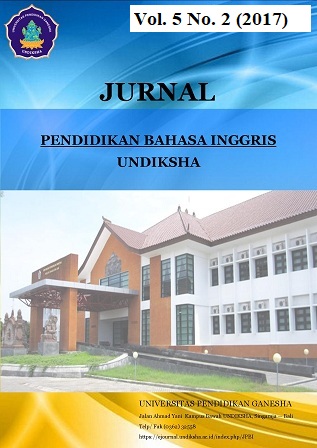DEVELOPING STORY JUMPER-BASED TEACHING MEDIA TO ENRICH KINDERGARTEN STUDENTS' VOCABULARY
DOI:
https://doi.org/10.23887/jpbi.v5i2.18863Abstract
Kebutuhan untuk mengintegrasikan teknologi dalam aktifitas pembelajaran sangatlah penting, terlebih lagi semenjak pembelajaran di era sekarang ini dipengaruhi oleh Revolusi Industri 4.0 dan menjadi Edukasi 4.0. Maka dari itu, selama masa transisi, para guru membutuhkan bantuan untuk membuat media berbasis teknologi untuk diimplementasikan pada pembelajaran mereka. Penelitian ini bertujuan untuk mengetahui pengembangan media pembelajar berbasis story jumper yang digunakan untuk memperkaya kosa kata murid TK, dan mengetahui kualitas dari media tersebut. Penelitian ini menggunakan penelitian Design and Development Research. Subyek penelitian ini adalah guru, sebagai pengguna, dan murid-murid di TK Lab. Undiksha. Penelitian menggunakan ADDIE model selama pengembangannya. Untuk mengetahui kualitas media yang akan digunakan, ahli menggunakan observasi kelas, kuesioner dari 3 guru setelah pengimplementasian media, dan wawancara dari 3 siswa. Menurut para guru, media yang digunakan sudah bagus untuk membantu guru menyampaikan materi pembelajaran, dan terlebih lagi medianya sangat gampang untuk digunakan. Sedangkan saat wawancara, para siswa mengaku bahwa media yang digunakan mampu menari perhatian mereka karena medianya sangat menyenangkan dan menarik dalam berbagai aspek. Dapat disimpulkan bahwa pengembangan media melalui proses ADDIE yaitu Analysis, Design, Development, Implementation, dan Evaluation, dan menurut temuan penelitian, media yang digunakan sudah bagus dan bisa digunakan untuk implementasi selanjutnya. Dari penelitian ini, para guru bisa merujuk pada Story Jumper saat ingin mengembangkan media berbasis teknologi mereka sendiri.Kata Kunci : Kata Kunci: ADDIE model, Media Pembelajaran Berbasis Story Jumper, Pelajar Usia Dini.
The demand of integrating technology in teaching and learning session is essential since today’s learning is affected by Revolution Industry 4.0 and became Education 4.0. Thus, during the transition, teachers are in need of help in creating suitable media to be implemeneted in their learning. This research aimed to know the development of story jumper-based teaching media into media that were used to enrich kindergarten students’ vocabulary, and to know the quality of the media. This research was Design and Development Research. The subject of this research were the teachers, as the user, and the students of TK Lab. Undiksha. This research used ADDIE model during the development. To know the quality of the media, the researcher used classroom observation, post-implementation questionnaire from 3 teachers, and an interview of 3 students. According to the teachers, the media are good in helping the teachers delivering the material, and moreover it is very easy to use. Meanwhile in the interview, the students admitted that the media were able to attract their attention because the media were fun and attractive in many ways. As the result, the development of the media went through the process of ADDIE that are Analysis, Design, Development, Implementation, and Evaluation, and the media produced are good enough to be used in further implementation. From this research, the teachers could refer to Story Jumper when developing an ICT-based teaching media because of its practicality and benefits in helping them achieving the learning outcomes.
keyword : Keywords: ADDIE model, Story Jumper-based teaching media, Young learners.
Published
2019-07-22
Issue
Section
Articles
License
Authors who publish with the Jurnal Pendidikan Bahasa Inggris Undiksha agree to the following terms:- Authors retain copyright and grant the journal the right of first publication with the work simultaneously licensed under a Creative Commons Attribution License (CC BY-SA 4.0) that allows others to share the work with an acknowledgment of the work's authorship and initial publication in this journal
- Authors are able to enter into separate, additional contractual arrangements for the non-exclusive distribution of the journal's published version of the work (e.g., post it to an institutional repository or publish it in a book), with an acknowledgment of its initial publication in this journal.
- Authors are permitted and encouraged to post their work online (e.g., in institutional repositories or on their website) prior to and during the submission process, as it can lead to productive exchanges, as well as earlier and greater citation of published work. (See The Effect of Open Access)













